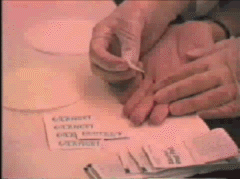|
Blood
Laboratory |
Hemostasis
>
Clotting and bleeding time
tests |
| |
Hemostasis
(literally - blood halting) depends on three
interrelated and overlapping sets of events:
- Constriction of the
blood vessels and formation of a platelet
"plug"
- Blood clotting
- Clot retraction
|
|
Review the topics in your textbook. |
|
Clotting time test |
|
In order for
blood to clot, the enzyme thrombin must be
generated from the plasma precursor prothrombin.
Thrombin then converts soluble fibrinogen into
insoluble fibrin. Generation of thrombin involves
the sequential activation of a number of other
plasma clotting factor, this process is also being
assisted by Ca++ and by factors released by platelets
and damaged tissues . The time taken
for blood to clot mainly reflects the time
required for the generation of thrombin in this
manner. If the plasma concentration of prothrombin or of some of the other factors is
low (or if the factor is absent, or functionally
inactive), clotting time will be prolonged. The
expected range for clotting time is 4-10 mins. |
|
|

|
|
|
Observe and
listen to the procedure for determining clotting time |
|
Bleeding time test |
| This test
measures the time taken for blood vessel
constriction and platelet plug formation to
occur. No clot is allowed to form, so that the
arrest of bleeding depends exclusively on blood
vessel constriction and platelet action. |

|
| |
| Observe and listen to the procedure for
determining bleeding time. |
|
|
| |
|
To continue with the next
section, Prothrombin Time and Partial Thromboplastin Time, click here |